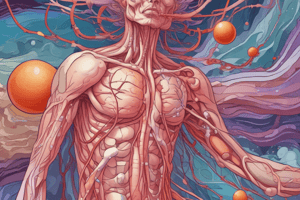Podcast
Questions and Answers
What stimulates the release of ADH?
What stimulates the release of ADH?
- Thirst (correct)
- Hemorrhage
- GI loss
- Diuretic therapy
When is the release of ADH inhibited by the vascular system?
When is the release of ADH inhibited by the vascular system?
- After diuretic therapy
- After hemorrhage
- When volume in the vascular system is low
- When volume in the vascular system is high (correct)
What may cause hypovolemia?
What may cause hypovolemia?
- Inadequate intake (correct)
- Thirst
- Constipation
- Dry, cracked mucous membranes
What is the average adult urine output?
What is the average adult urine output?
What activates the thirst mechanism when fluid is lost?
What activates the thirst mechanism when fluid is lost?
What may lead to decreased organ function if not treated properly?
What may lead to decreased organ function if not treated properly?
What are examples of fluid losses mentioned in the text?
What are examples of fluid losses mentioned in the text?
What does THIRST stimulate the release of?
What does THIRST stimulate the release of?
What causes the release of ADH when the volume in the vascular system is low?
What causes the release of ADH when the volume in the vascular system is low?
What assessments should be performed for a patient with hypervolemia?
What assessments should be performed for a patient with hypervolemia?
What is the purpose of diuretics like Furosemide (Lasix)?
What is the purpose of diuretics like Furosemide (Lasix)?
What should be assessed prior to administration of Furosemide (Lasix)?
What should be assessed prior to administration of Furosemide (Lasix)?
What are the signs and symptoms of fluid accumulation in the lungs?
What are the signs and symptoms of fluid accumulation in the lungs?
How is pitting edema graded?
How is pitting edema graded?
What should be monitored for a patient with edema?
What should be monitored for a patient with edema?
What should be assessed after administration of diuretics like Furosemide (Lasix)?
What should be assessed after administration of diuretics like Furosemide (Lasix)?
What is the purpose of elevating lower extremities, applying compression stockings, encouraging movement, and massaging the area for edema?
What is the purpose of elevating lower extremities, applying compression stockings, encouraging movement, and massaging the area for edema?
What do pitting edema and jugular vein distention indicate?
What do pitting edema and jugular vein distention indicate?
Flashcards are hidden until you start studying
Study Notes
Regulation of ADH Release
- Low blood volume or low blood pressure stimulates the release of ADH (Antidiuretic Hormone)
- The release of ADH is inhibited by the vascular system when blood volume or blood pressure is high
Hypovolemia
- Hypovolemia can be caused by excessive sweating, vomiting, diarrhea, or bleeding
- Hypovolemia can lead to decreased organ function if not treated properly
Thirst Mechanism
- The thirst mechanism is activated when fluid is lost, stimulating the release of ADH
- ADH stimulates the release of vasopressin, which stimulates water reabsorption in the kidneys
Fluid Losses
- Examples of fluid losses include vomiting, diarrhea, and excessive sweating
Diuretics and Edema
- Diuretics like Furosemide (Lasix) are used to remove excess fluid from the body
- Assessments for a patient with hypervolemia include vital signs, lung sounds, and peripheral edema
- Prior to administration of Furosemide (Lasix), the patient's potassium level, lung sounds, and urine output should be assessed
- Signs and symptoms of fluid accumulation in the lungs include crackles, wheezing, and shortness of breath
- Pitting edema is graded on a scale of +1 to +4, depending on the depth of indentation
- For a patient with edema, monitor vital signs, lung sounds, and peripheral edema
- After administration of diuretics like Furosemide (Lasix), monitor urine output, potassium level, and lung sounds
- Elevating lower extremities, applying compression stockings, encouraging movement, and massaging the area can help reduce edema
- Pitting edema and jugular vein distention indicate fluid accumulation and increased central venous pressure
Studying That Suits You
Use AI to generate personalized quizzes and flashcards to suit your learning preferences.



